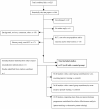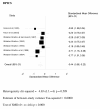The clinical effectiveness of different parenting programmes for children with conduct problems: a systematic review of randomised controlled trials
- PMID: 19261188
- PMCID: PMC2660289
- DOI: 10.1186/1753-2000-3-7
The clinical effectiveness of different parenting programmes for children with conduct problems: a systematic review of randomised controlled trials
Abstract
Background: Conduct problems are common, disabling and costly. The prognosis for children with conduct problems is poor, with outcomes in adulthood including criminal behaviour, alcoholism, drug abuse, domestic violence, child abuse and a range of psychiatric disorders. There has been a rapid expansion of group based parent-training programmes for the treatment of children with conduct problems in a number of countries over the past 10 years. Existing reviews of parent training have methodological limitations such as inclusion of non-randomised studies, the absence of investigation for heterogeneity prior to meta-analysis or failure to report confidence intervals. The objective of the current study was to systematically review randomised controlled trials of parenting programmes for the treatment of children with conduct problems.
Methods: Standard systematic review methods were followed including duplicate inclusion decisions, data extraction and quality assessment. Twenty electronic databases from the fields of medicine, psychology, social science and education were comprehensively searched for RCTs and systematic reviews to February 2006. Inclusion criteria were: randomised controlled trial; of structured, repeatable parenting programmes; for parents/carers of children up to the age of 18 with a conduct problem; and at least one measure of child behaviour. Meta-analysis and qualitative synthesis were used to summarise included studies.
Results: 57 RCTs were included. Studies were small with an average group size of 21. Meta-analyses using both parent (SMD -0.67; 95% CI: -0.91, -0.42) and independent (SMD -0.44; 95% CI: -0.66, -0.23) reports of outcome showed significant differences favouring the intervention group. There was insufficient evidence to determine the relative effectiveness of different approaches to delivering parenting programmes.
Conclusion: Parenting programmes are an effective treatment for children with conduct problems. The relative effectiveness of different parenting programmes requires further research.
Figures
Similar articles
-
School-based interventions for reducing disciplinary school exclusion: a systematic review.Campbell Syst Rev. 2018 Jan 9;14(1):i-216. doi: 10.4073/csr.2018.1. eCollection 2018. Campbell Syst Rev. 2018. PMID: 37131379 Free PMC article.
-
The effectiveness and cost-effectiveness of parent training/education programmes for the treatment of conduct disorder, including oppositional defiant disorder, in children.Health Technol Assess. 2005 Dec;9(50):iii, ix-x, 1-233. doi: 10.3310/hta9500. Health Technol Assess. 2005. PMID: 16336845 Review.
-
Systematic reviews of the effectiveness of day care for people with severe mental disorders: (1) acute day hospital versus admission; (2) vocational rehabilitation; (3) day hospital versus outpatient care.Health Technol Assess. 2001;5(21):1-75. doi: 10.3310/hta5210. Health Technol Assess. 2001. PMID: 11532238 Review.
-
Equity effects of parenting interventions for child conduct problems: a pan-European individual participant data meta-analysis.Lancet Psychiatry. 2019 Jun;6(6):518-527. doi: 10.1016/S2215-0366(19)30162-2. Epub 2019 May 6. Lancet Psychiatry. 2019. PMID: 31072801
-
The future of Cochrane Neonatal.Early Hum Dev. 2020 Nov;150:105191. doi: 10.1016/j.earlhumdev.2020.105191. Epub 2020 Sep 12. Early Hum Dev. 2020. PMID: 33036834
Cited by
-
Costs and longer-term savings of parenting programmes for the prevention of persistent conduct disorder: a modelling study.BMC Public Health. 2011 Oct 14;11:803. doi: 10.1186/1471-2458-11-803. BMC Public Health. 2011. PMID: 21999434 Free PMC article.
-
Do Parents Perceive Practitioners to Have a Specific Role in Change? A Longitudinal Study Following Participation in an Evidence-Based Program.Int J Environ Res Public Health. 2022 Jul 26;19(15):9100. doi: 10.3390/ijerph19159100. Int J Environ Res Public Health. 2022. PMID: 35897464 Free PMC article.
-
A church-based intervention for families to promote mental health and prevent HIV among adolescents in rural Kenya: Results of a randomized trial.J Consult Clin Psychol. 2016 Jun;84(6):511-525. doi: 10.1037/ccp0000076. Epub 2016 Mar 17. J Consult Clin Psychol. 2016. PMID: 26985727 Free PMC article. Clinical Trial.
-
Group-based parent training programmes for improving emotional and behavioural adjustment in young children.Cochrane Database Syst Rev. 2016 Aug 1;2016(8):CD003680. doi: 10.1002/14651858.CD003680.pub3. Cochrane Database Syst Rev. 2016. PMID: 27478983 Free PMC article.
-
Effectiveness of an Internet-Based and Telephone-Assisted Training for Parents of 4-Year-Old Children With Disruptive Behavior: Implementation Research.J Med Internet Res. 2022 Apr 4;24(4):e27900. doi: 10.2196/27900. J Med Internet Res. 2022. PMID: 35377332 Free PMC article. Clinical Trial.
References
-
- Office for National Statistics The mental health of children and adolescents in Great Britain. Access date: 28 Oct. 2003.
-
- Kazdin AE. Conduct disorders in childhood and adolescence. 2. London: SAGE Publications; 1996.
-
- Moffit TE, Caspi A, Dickson N, Silva P, Stanton W. Childhood-onset versus adolescent-onset antisocial conduct problems in males: Natural history from ages 3 to 18 years. Development and Psychopathology. 1996;8:399–424. doi: 10.1017/S0954579400007161. - DOI
-
- Champion LA, Goodall G, Rutter M. Behavior problems in childhood and stressors in early adult life: 1. A 20 year follow-up of London school children. Psych Med. 1995;25:231–246. - PubMed
LinkOut - more resources
Full Text Sources
Miscellaneous





